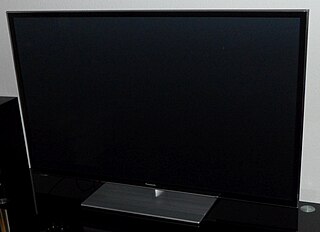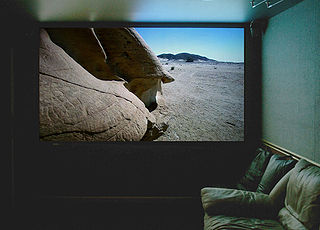ClearType is Microsoft's implementation of subpixel rendering technology in rendering text in a font system. ClearType attempts to improve the appearance of text on certain types of computer display screens by sacrificing color fidelity for additional intensity variation. This trade-off is asserted to work well on LCD flat panel monitors.

In digital imaging, a pixel, pel, or picture element is the smallest addressable element in a raster image, or the smallest addressable element in a dot matrix display device. In most digital display devices, pixels are the smallest element that can be manipulated through software.

Interlaced video is a technique for doubling the perceived frame rate of a video display without consuming extra bandwidth. The interlaced signal contains two fields of a video frame captured consecutively. This enhances motion perception to the viewer, and reduces flicker by taking advantage of the phi phenomenon.

A plasma display panel (PDP) is a type of flat panel display that uses small cells containing plasma: ionized gas that responds to electric fields. Plasma televisions were the first large flat panel displays to be released to the public.

An LCD projector is a type of video projector for displaying video, images or computer data on a screen or other flat surface. It is a modern equivalent of the slide projector or overhead projector. To display images, LCD projectors typically send light from a metal-halide lamp through a prism or series of dichroic filters that separates light to three polysilicon panels – one each for the red, green and blue components of the video signal. As polarized light passes through the panels, individual pixels can be opened to allow light to pass or closed to block the light. The combination of open and closed pixels can produce a wide range of colors and shades in the projected image.

A video projector is an image projector that receives a video signal and projects the corresponding image on a projection screen using a lens system. Video projectors use a very bright ultra-high-performance lamp, Xenon arc lamp, LED or solid state blue, RB, RGB or remote fiber-optic RGB lasers to provide the illumination required to project the image, and most modern ones can correct any curves, blurriness, and other inconsistencies through manual settings. If a blue laser is used, a phosphor wheel is used to turn blue light into white light, which is also the case with white LEDs. A wheel is used in order to prolong the lifespan of the phosphor, as it is degraded by the heat generated by the laser diode. Remote fiber-optic RGB laser racks can be placed far away from the projector, and several racks can be housed in a single, central room. Each projector can use up to two racks, and several monochrome lasers are mounted on each rack, the light of which is mixed and transmitted to the projector booth using optical fibers. Projectors using RB lasers use a blue laser with a phosphor wheel in conjunction with a conventional solid state red laser.

Digital Light Processing (DLP) is a set of chipsets based on optical micro-electro-mechanical technology that uses a digital micromirror device. It was originally developed in 1987 by Larry Hornbeck of Texas Instruments. While the DLP imaging device was invented by Texas Instruments, the first DLP-based projector was introduced by Digital Projection Ltd in 1997. Digital Projection and Texas Instruments were both awarded Emmy Awards in 1998 for the DLP projector technology. DLP is used in a variety of display applications from traditional static displays to interactive displays and also non-traditional embedded applications including medical, security, and industrial uses.

Subpixel rendering is used to increase the apparent resolution of a computer's display. It takes advantage of the fact that each pixel on a color liquid-crystal display (LCD) or similar is composed of individual red, green, and blue components — subpixels — with different locations, so that the color also causes the image to shift in space.
Flicker is a visible change in brightness between cycles displayed on video displays. It applies to the refresh interval on cathode ray tube (CRT) televisions and computer monitors, as well as plasma computer displays and televisions.
The contrast ratio (CR) is a property of a display system, defined as the ratio of the luminance of the brightest shade (white) to that of the darkest shade (black) that the system is capable of producing. A high contrast ratio is a desired aspect of any display. It has similarities with dynamic range.

A 3D display is a display device capable of conveying depth to the viewer. Many 3D displays are stereoscopic displays, which produce a basic 3D effect by means of stereopsis, but can cause eye strain and visual fatigue. Newer 3D displays such as holographic and light field displays produce a more realistic 3D effect by combining stereopsis and accurate focal length for the displayed content. Newer 3D displays in this manner cause less visual fatigue than classical stereoscopic displays.

An active shutter 3D system is a technique of displaying stereoscopic 3D images. It works by only presenting the image intended for the left eye while blocking the right eye's view, then presenting the right-eye image while blocking the left eye, and repeating this so rapidly that the interruptions do not interfere with the perceived fusion of the two images into a single 3D image.

A CRT projector is a video projector that uses a small, high-brightness cathode ray tube (CRT) as the image generating element. The image is then focused and enlarged onto a screen using a lens kept in front of the CRT face. The first color CRT projectors came out in the early 1950s. Most modern CRT projectors are color and have three separate CRTs, and their own lenses to achieve color images. The red, green and blue portions of the incoming video signal are processed and sent to the respective CRTs whose images are focused by their lenses to achieve the overall picture on the screen. Various designs have made it to production, including the "direct" CRT-lens design, and the Schmidt CRT, which employed a phosphor screen that illuminates a perforated spherical mirror, all within an evacuated cathode ray tube.
Fulldome refers to immersive dome-based video display environments. The dome, horizontal or tilted, is filled with real-time (interactive) or pre-rendered (linear) computer animations, live capture images, or composited environments.

Large-screen television technology developed rapidly in the late 1990s and 2000s. Prior to the development of thin-screen technologies, rear-projection television was standard for larger displays, and jumbotron, a non-projection video display technology, was used at stadiums and concerts. Various thin-screen technologies are being developed, but only liquid crystal display (LCD), plasma display (PDP) and Digital Light Processing (DLP) have been publicly released. Recent technologies like organic light-emitting diode (OLED) as well as not-yet-released technologies like surface-conduction electron-emitter display (SED) or field emission display (FED) are in development to replace earlier flat-screen technologies in picture quality.

The keystone effect is the apparent distortion of an image caused by projecting it onto an angled surface. It is the distortion of the image dimensions, such as making a square look like a trapezoid, the shape of an architectural keystone, hence the name of the feature. In the typical case of a projector sitting on a table, and looking upwards to the screen, the image is larger at the top than on the bottom. Some areas of the screen may not be focused correctly as the projector lens is focused at the average distance only.

Rear-projection television (RPTV) is a type of large-screen television display technology. Until approximately 2006, most of the relatively affordable consumer large screen TVs up to 100 in (250 cm) used rear-projection technology. A variation is a video projector, using similar technology, which projects onto a screen.
Electrically operated display devices have developed from electromechanical systems for display of text, up to all-electronic devices capable of full-motion 3D color graphic displays. Electromagnetic devices, using a solenoid coil to control a visible flag or flap, were the earliest type, and were used for text displays such as stock market prices and arrival/departure display times. The cathode ray tube was the workhorse of text and video display technology for several decades until being displaced by plasma, liquid crystal (LCD), and solid-state devices such as thin-film transistors (TFTs), LEDs and OLEDs. With the advent of metal–oxide–semiconductor field-effect transistors (MOSFETs), integrated circuit (IC) chips, microprocessors, and microelectronic devices, many more individual picture elements ("pixels") could be incorporated into one display device, allowing graphic displays and video.

3LCD is the name and brand of a major LCD projection color image generation technology used in modern digital projectors. 3LCD technology was developed and refined by Japanese imaging company Epson in the 1980s and was first licensed for use in projectors in 1988. In January 1989, Epson launched its first 3LCD projector, the VPJ-700.
The Qumi (DPC74A1) is a pocket projector manufactured by Delta Electronics for vendor Vivitek. It was released in May 2011.












